Buffered Vitamin C with Magnesium for Immune, Stress, and Tissue Support*
What It Does
Magnesium Ascorbate delivers dual-action support for immune health, antioxidant protection, and cellular energy.* Each capsule provides 500 mg of vitamin C and a bioavailable form of magnesium to promote normal cytokine balance, neurotransmitter function, and collagen synthesis.* The buffered form is gentler on the stomach compared to acidic ascorbic acid, making it ideal for sensitive individuals.*
How It Works
• Vitamin C: A key antioxidant and immune nutrient that supports innate and adaptive immune responses, cytokine balance, white blood cell activity, and histamine metabolism.*[1]
• Connective Tissue Support: Promotes the production of collagen and elastin, supporting the integrity of skin, bones, joints, and periodontal tissue.*[2–5]
• Adrenal and Brain Concentration: Concentrated in the adrenal glands and brain, vitamin C is required for catecholamine synthesis (dopamine to norepinephrine) and serotonin production, essential for stress adaptation and mood regulation.[6]
• Neurovascular Function: Helps protect blood vessels and supports brain function through antioxidant effects and neurotransmitter modulation.* [7–8]
• Magnesium: An essential mineral that works with vitamin C to support enzymatic reactions related to energy production, nerve signaling, and muscular relaxation.*
Who It’s For
This product is ideal for individuals seeking comprehensive antioxidant and immune support, especially those with sensitive digestion or high stress demands requiring enhanced nutrient support.*
Special Features
Buffered to a neutral pH for improved gastrointestinal tolerance, this formulation is part of Allergy Research Group®'s legacy of low-allergen, high-purity vitamin C products.
References
1. Mousavi S, et al. Eur J Microbiol Immunol. 2019;9(3):73-9.
2. Pullar JM, et al. Nutrients. 2017;9(8):866. https://doi.org/10.3390/nu9080866
3. Malmir H, et al. Br J Nutr. 2018;119(8):847-58.
4. Brzezińska O, et al. Nutrients. 2020;12(8):2394. https://doi.org/10.3390/nu12082394
5. Tada A, Miura H. Int J Environ Res Public Health. 2019;16(14):2472. https://doi.org/10.3390/ijerph16142472
6. Harrison FE, May JM. Free Radic Biol Med. 2009;46(6):719-30.
7. May JM, Harrison FE. Antioxid Redox Signal. 2013;19(17):2068-83.
8. Travica N, et al. Front Aging Neurosci. 2019;11:72. doi:10.3389/fnagi.2019.00072





